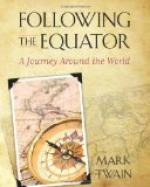On some part of this railway journey we saw gorse and broom—importations from England—and a gentleman who came into our compartment on a visit tried to tell me which—was which; but as he didn’t know, he had difficulty. He said he was ashamed of his ignorance, but that he had never been confronted with the question before during the fifty years and more that he had spent in Australia, and so he had never happened to get interested in the matter. But there was no need to be ashamed. The most of us have his defect. We take a natural interest in novelties, but it is against nature to take an interest in familiar things. The gorse and the broom were a fine accent in the landscape. Here and there they burst out in sudden conflagrations of vivid yellow against a background of sober or sombre color, with a so startling effect as to make a body catch his breath with the happy surprise of it. And then there was the wattle, a native bush or tree, an inspiring cloud of sumptuous yellow bloom. It is a favorite with the Australians, and has a fine fragrance, a quality usually wanting in Australian blossoms.
The gentleman who enriched me with the poverty of his formation about the gorse and the broom told me that he came out from England a youth of twenty and entered the Province of South Australia with thirty-six shillings in his pocket—an adventurer without trade, profession, or friends, but with a clearly-defined purpose in his head: he would stay until he was worth L200, then go back home. He would allow himself five years for the accumulation of this fortune.
“That was more than fifty years ago,” said he. “And here I am, yet.”
As he went out at the door he met a friend, and turned and introduced him to me, and the friend and I had a talk and a smoke. I spoke of the previous conversation and said there something very pathetic about this half century of exile, and that I wished the L200 scheme had succeeded.
“With him? Oh, it did. It’s not so sad a case. He is modest, and he left out some of the particulars. The lad reached South Australia just in time to help discover the Burra-Burra copper mines. They turned out L700,000 in the first three years. Up to now they have yielded L120,000,000. He has had his share. Before that boy had been in the country two years he could have gone home and bought a village; he could go now and buy a city, I think. No, there is nothing very pathetic about his case. He and his copper arrived at just a handy time to save South Australia. It had got mashed pretty flat under the collapse of a land boom a while before.” There it is again; picturesque history —Australia’s specialty. In 1829 South Australia hadn’t a white man in it. In 1836 the British Parliament erected it—still a solitude—into a Province, and gave it a governor and other governmental machinery. Speculators took hold, now, and inaugurated a vast land scheme, and invited immigration, encouraging




